Cremation
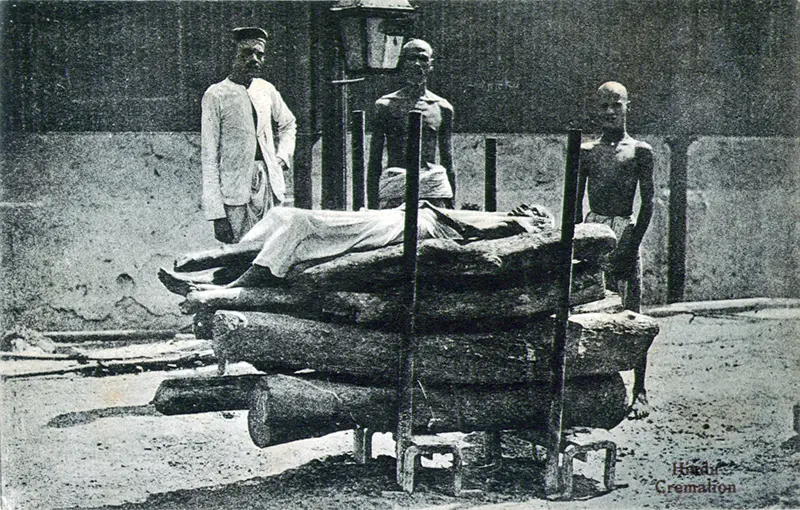
Hindu Cremation
This unused postcard has the printed text...
1040
Printed in Saxony
The Indian religions, such as Hinduism, Jainism, Sikhism and Buddhism, mandate open-air cremation. In these religions, the body is seen as an instrument to carry the soul. According to Hindu philosophy the human body is a combination of five basic natural elements; fire, water, air, earth and space or ether. When one dies, fire ceases, and that living form is sent to its original state of creation. Fire (in the form of cremation) is used to complete the fifth element. According to Hindu traditions, the reasons for preferring to destroy the corpse by fire, over burying it into ground, is to induce a feeling of detachment into the freshly disembodied spirit, which will be helpful to encourage it into passing to "the other world".
Criminals
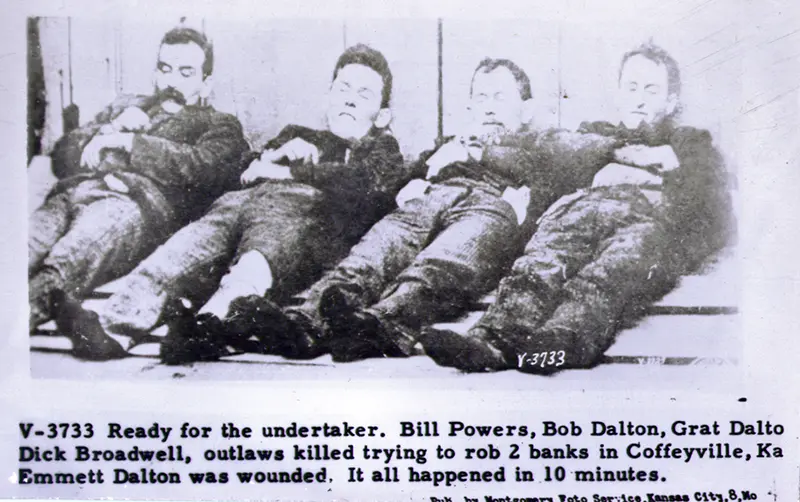
The Dalton Gang
This unused postcard has the printed text...
V-3733
Pub. by Montgomery Foto Services, Kansas City, 8, Mo.
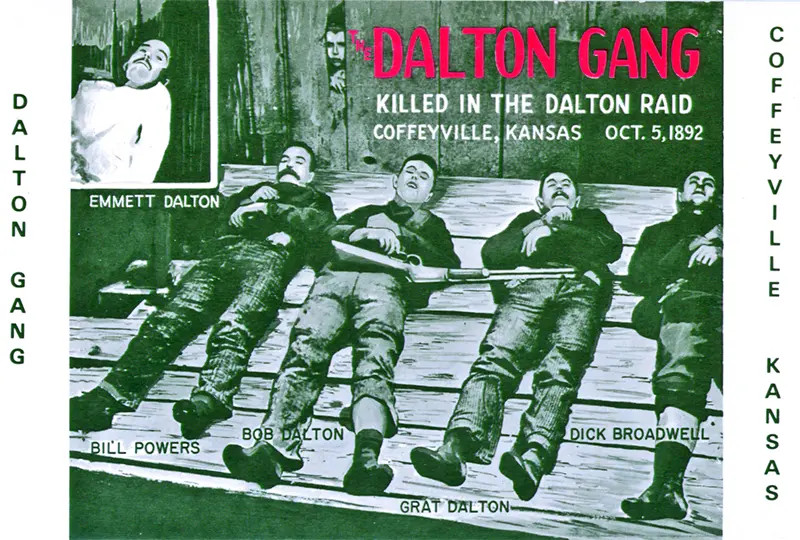
The Dalton Gang
This unused postcard has the printed text...
P310531
Dunlap Post Card Co., Omaha, Nebraska 68114
Plastichrome, boston, MA 02130 4598
The Dalton Gang
On October 5, 1892, the notorious Dalton Gang attempted to rob two
banks in Coffeyville, Kansas. Bob Dalton, Grat Dalton, Bill Powers and
Dick Broadwell were killed and Emmett Dalton was seriously wounded by
the famed Dalton Defenders. A lad named Ray Clark immortalized himself
by peering through the fence at the exact moment a pioneer photographer
took a picture of the four dead Dalton Raid bandits.
Emmett Dalton survived the raid but received 23 gunshot wounds. He was given a life sentence in the penitentiary in Lansing, Kansas and was pardoned after fourteen years. He moved to California and became a real estate agent, author and actor, dying at the age of sixty-six on July 13th, 1937
Death Beds

The room where Mrs. Washington died - Mount Vernon, Virginia
This unused postcard has the printed text...
Copyright 1920, by the Mount Vernon Association
Martha Dandridge was born in New Kent County, Virginia, to John Dandridge and Frances Jones on June 2, 1731. In 1749 she married Daniel Parke Custis and lived with him at his estate, the White House, also in New Kent. The couple had four children; Daniel, Frances, John and Martha. Her husband, Daniel died suddenly in 1757, at which time Martha Custis became a wealthy widow. Colonel George Augustine Washington paid two visits to Martha Custis at the White House in the spring of 1758. The two married a little less than a year later, on January 6, 1759. Martha Washington moved to her new husband's home, Mount Vernon, three months later, in April 1759. On December 14, 1799, George Washington died at home. Martha died on May 22, 1802, and her body was placed in the family vault on the estate. In 1831, her remains were moved from their original burial site a few hundred feet to a brick tomb that overlooks the Potomac River.
Ethnic

Neck Rings
This unused postcard has the printed text...
B3236
LB 2876
8711865314370
Langnekken
Collectie Spaarnestad Fotoarchief, Haarlem
First Edition
Postbus 1760 1000 BT Amsterdam
Printed in Holland
In some cultures, such as the Kayan, also known as the Padaung, of northern Thailand near Burma (Myanmar) and the Ndebele of South Africa neck rings are worn. No one seems to know why the practice started. Various reasons are given such as longer looking necks are more attractive to their menfolk, they made women unattractive to slave traders, to protect against being bitten by tigers or that it resembles the neck of a dragon. Girls start wearing the coils from about five years old onward and these are replaced by larger coils as they grow. Their necks are not really elongated, what is happening is that the clavicle and ribcage is actually being pushed downward.
I think these are Kayan women as they are also wearing the arm and leg coils that many of them do. The trio in the photo were part of a circus troupe and they were photographed in their hotel in London in 1935.

Shrunken Heads
This postcard, posted in Chicago on July 17th, 1939, has the printed text...
Field Museum of Natural History
Chicago, U. S. A.
Human Shrunken Heads
Hall 9
Heads of slain enemies were shrunk to the size of a man's fist by the Jivaro Indians of Eastern Ecuador and Peru, South America. These were preserved as trophies and used in certain ceremonies. The process of preparation was complex. Long slits were cut [in the back of the head] and all of the skul, brain and facial bones removed without disturbing the features. The head was then boiled in water containing an astringent herb. Then hot stones of gradually decreasing size were placed inside the head, causing the flesh slowly to contract. Finally the stones were were removed and the slits carefully sewn together. Often the lips of the head thus shrunk to about one fourth size were also sewed together in the belief this would prevent the victim from harming the slayer.
The hand-written message on the card is also interesting...
Hello Clora,
I am sending you one of these heads under separate cover, so you can hang it in your bedroom for company while R. L. is away.
Marcus - The Rat
Exaggeration
This section was started because of my hobby of collecting Terre Haute postcards. Whilst collecting these postcards I came across a couple of exaggeration or "tall tale" postcards. This type of postcard were produced from almost the start of postcard production - and you thought "photoshopping" was new!*
The main themes were usually fish, fruit or vegetables but almost any subject was used. Many were produced to advertise a particular state or area with captions such as "that's the way we grow them in xxxxx" or "bigger and better in xxxxx".
There were several techniques used to produce the images. One way was to use a photo-montage, another was to use a mixture of artistry and photography.
One of the best known producers of these exaggerated or "tall tale" cards was William H. "Dad" Martin of Ottawa, Kansas. His studio started experimenting with trick photography in 1908. A year later, in 1909, he formed the Martin Post Card Company. This company was so succesful that the company was reportedly producing around seven million postcards annually.
* Some people absolutely hate the idea of Adobe's Photoshop being used as a verb (a doing word) or adjective (a describing word) rather than a noun (a name, person, place or thing word). The fact is that Adobe's Photoshop is the standard against which all other image manipulation programs are measured against and it's not surprising that it's now used as a verb or adjective; much like Hoover was in the world of vacuum cleaners - as in "doing the hoovering". It's also now used as a common noun - people now speak of using other image editing programs, such as GIMP, to photoshop an image! There's an interesting discussion of this and the use of image manipulation in general at Scott Bulger's Photography Blog.
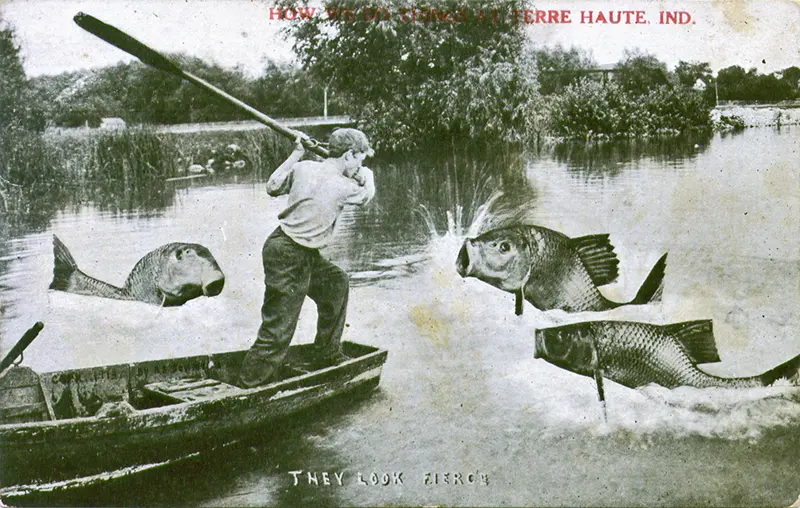
Big Fish
How We Do Things in Terre Haute
They Look Fierce
This postcard, posted in Terre Haute on July 17th, but with an unreadable year, has the printed text...
Johnson, Photographer, Waupun, Wi.
This type of card is known as a Tall Tale or Exaggeration Postcard and were very popular in the 1900s.
Famine
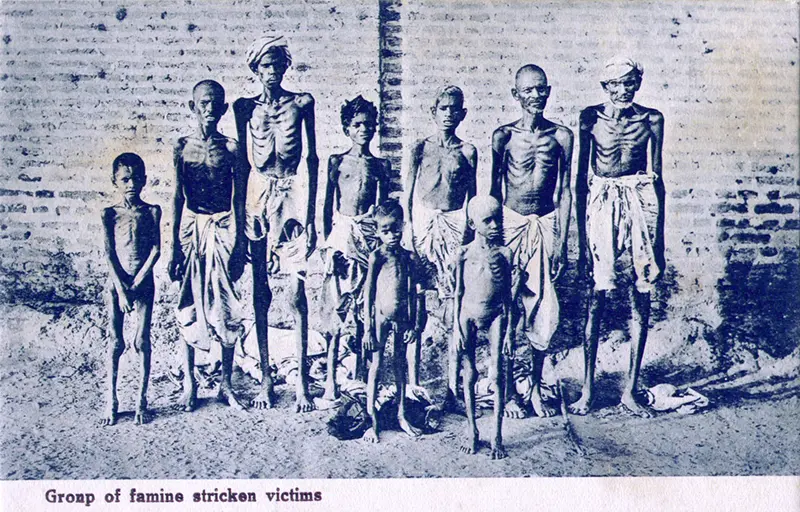
Group of Famine Stricken Victims
This unused postcard has the printed text...
313
Printed in Saxony
Most parts of the world are subject to famine at one time or another. The cuase can be either crop failure, over population for available food resources, failure to distribute available food properly or a variety of other causes, either man-made or natural. India is dependant on the monsoon rains for much of its food and when these fail then widespread famine results. For example, between 1963 and 1966, three years of drought resulted in 1.5 million deaths due to starvation and disease.
Film Noir
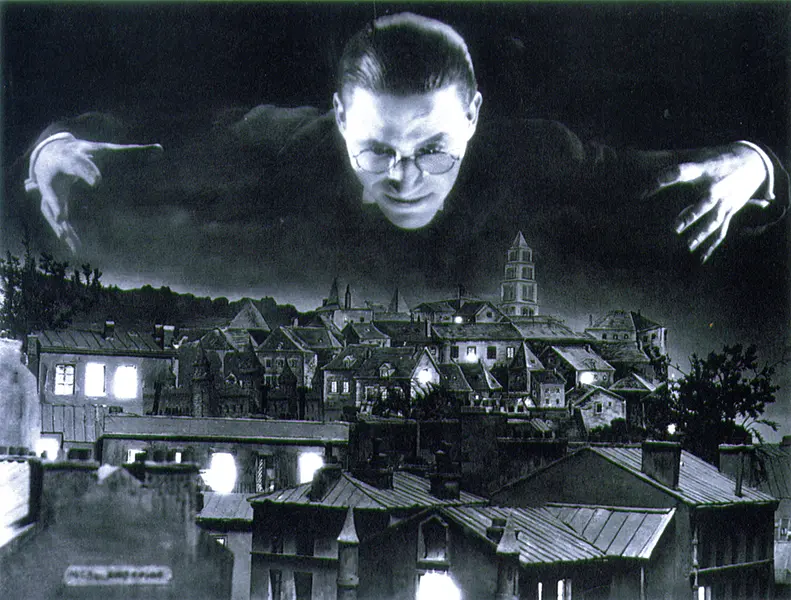
Film Noir
This unused postcard, which seems to be a reproduction of a much earlier postcard, has the printed text...
56532
Film: Non-identifie
Production UFA
Collection Cinematheque Suisse, CH-Lausanne
News Productions, CH-1446 Baulmes - DR
Filmwelt Berlin, D-31848 Bakede
News Productions, Stroud GL5 3EH
Printed in EEC
Universum Film AG, (originally Universum Film Aktiengesellschaft) better known as UFA or Ufa, was the principal film studio in Germany, home of the German film industry during the Weimar Republic and through World War II, and a major force in world cinema from 1917 to 1945. After World War II, UFA continued producing movies and television programmes to the present day, making it the longest standing film company in Germany. Source: Wikipedia